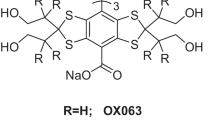Abstract
The diffusional water permeability (P d) of the red blood cell (RBC) membrane of rat, rabbit and sheep, representing some animal species introduced to Australia, has been monitored, by a Mn2+-doping 1H nuclear magnetic resonance (NR) technique using a high-field spectometer operating at 400 MHz. In order to make comparisons with previous measurements on the same species (performed at 25 MHz) an analysis of the influence of instrumental parameters and of the state of blood oxygenation was performed on samples of rat and rabbit blood. It was found that by using a short interpulse delay (around 100 µs) in the Carr-Purcell-Meiboom-Gill sequence, and by performing the measurements of the transverse relaxation time of the water in the cell interior (T 2i) on packed cells (haematocrit >95%), the values of the water exchange time (T e) obtained with a high-field spectrometer are comparable with those obtained by using a low-field NMR spectrometer. The values of the diffusional water permeability (P d), calculated from the T e values, were, at 24.6°C around 10 × 10−3 cm/s in case of rat and rabbit RBC and around 5 × 10−3 cm/s for sheep RBC; at 37°C the P d values were around 16 × 10−3 cm/s for rat RBC, 14 × 10−3 cm/s for rabbit RBC and 7 × 10−3 cm/s for sheep RBC. These values are very close to the P d values previously reported for the European counterparts of these species. There were no significant differences in the P d values between laboratory rabbits and wild rabbits, or between castrated males, pregnant or nonpregnant females. These results suggest that no changes in the RBC water permeability are correlated with marked alterations in the habitat of animal species introduced to Australia or by sex hormone status. If the NMR instrument-parameters are carefully chosen then comparative studies of RBC water permeability in different laboratories, at separate locations and using different instruments are meaningful.
Similar content being viewed by others
References
Benga Gh, Pop VI, Popescu O et al. (1987) Effects of temperatures on water diffusion in human erythrocytes and ghosts — nuclear magnetic resonance studies. Biochim Biophys Acta 905:339–348
Benga Gh, Pop VI, Popescu O et al. (1990) On measuring the diffusional water permeability of human red blood cells and ghosts by nuclear magnetic resonance. J Biochem Biophys Methods 21:87–102.
Benga Gh, Borza T, Popescu O et al. (1993a) Magnetic resonance studies of diffusional water permeability of red blood cells from sheep and cow. Comp Biochem Physiol 104B:589–594
Benga Gh, Chapman BE, Gallagher CH et al. (1993b) NMR studies of diffusional water permeability from eight species of marsupial. Comp Biochem Physiol 106B:573–590
Benga Gh, Chapman BE, Gallagher CH et al. (1993c) NMR studies in diffusional water permeability of red cells from Macropodid marsupials (kangeroo and wallabies). Comp Biochem Physiol 104A:799–803
Benga Gh, Matei H, Borza T et al. (1993d) Comparative nuclear magnetic resonance studies of diffusional water permeability of red blood cells from different species. 5. Rabbit. Comp Biochem Physiol 104A:491–495
Benga Gh, Matei H, Borza T et al. (1993e) Comparative nuclear magnetic resonance studies on water diffusional permeability of red blood cells from mice and rats. Comp Biochem Physiol 104A:491–495.
Benga Gh, Ralston GB, Borza T et al. (1994) NMR studies of diffusional permeability of red blood cells from the Echidna. Comp Biochem Physiol 107B:45–50
Brindle KM, Brown FF, Campbell ID et al. (1979) Application of spin echo nuclear magnetic resonance to whole cell systems: membrane transport. Biochem J 180:37–44
Bubb WA, Kirk K, Kuchel PW (1988) Ethylene glycol as an X nucleus thermometer for biological samples. J Magn Reson 77:363–368
Conlon T, Outhred R. (1972) Water diffusion permeability of erythrocytes using an NMR technique. Biochim Biophys Acta 288:354–361
Endre ZH, Chapham BE, Kuchel PW (1984) Cell volume dependence of 1H spin echo NMR signals in human erythrocyte suspensions: the influence of in-situ filled gradients. Biochim Biophys Acta 803:137–144
Farrar TC, Becker ED (1971) Pulse and fourier transform NMR. Academic Press, New York
Author information
Authors and Affiliations
Rights and permissions
About this article
Cite this article
Benga, G., Chapman, B.E., Hinds, L. et al. Comparative NMR studies of diffusional water permeability of erythrocytes from some animals introduced to Australia: Rat rabbit and sheep. Comp Haematol Int 4, 232–235 (1994). https://doi.org/10.1007/BF00185179
Issue Date:
DOI: https://doi.org/10.1007/BF00185179




